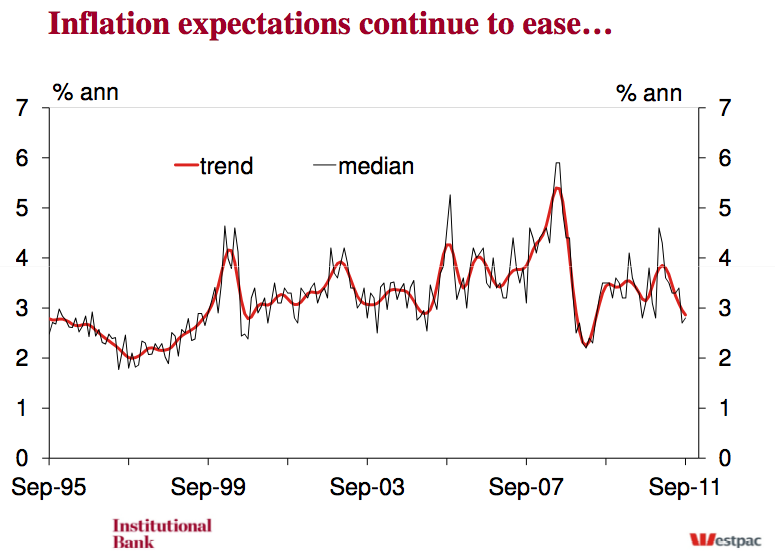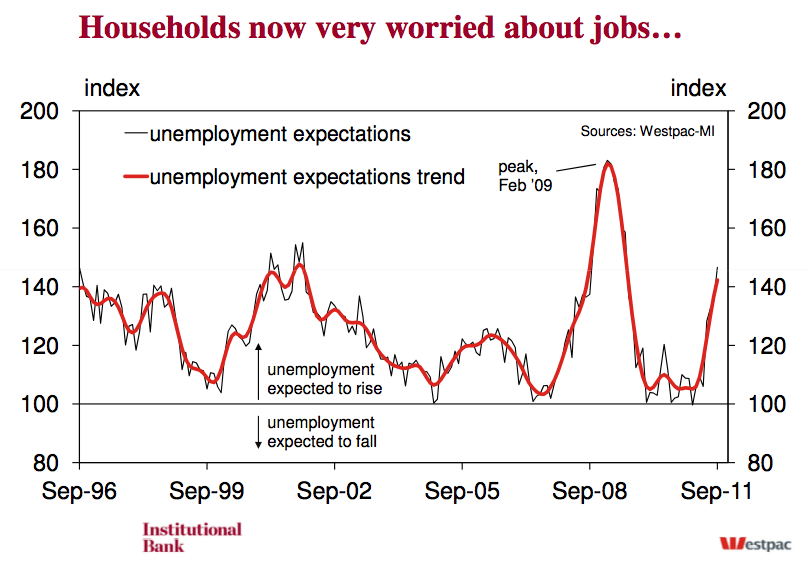Westpac has today released its “Expectations Chart Pack”, which includes both inflation and employment expectations (find it below).
This month’s results are fascinating. It is no surprise that consumers view of future inflation remains unchanged from last month as the heat has gone out of the CPI debate:

I am a little surprised, however, at the extent of the rise in unemployment expectations after only a month or so of obviously poor employment data:

The point at which expectations broke out of a tight trading range looks to have been well before the current round of obvious labour market weakness. If I can get the raw data I’ll come back to you on that.
Bill Evans has the following to say:
Household are increasing worried about the jobs market. History tells us that this observation is consistent with weak jobs growth and rising unemployment. How households are interpreting the labour market is consistent with picture painted by the ABS labour force survey.
Household unemployment expectations rose 8.5% in September following on from a 2.0% gain in August. Remembering that a rise in unemployment expectations is consistent with a deterioration in the labour market it is quite revealing that unemployment expectation have risen almost 35% so far this year to be up 44% over the last 12 months. This suggests that households are observing a softer jobs market and are worried about the outlook for jobs. This has now been confirmed in the ABS data which reported a rise in the unemployment rate from a recent low of 4.9% to 5.3% in August.
It is also worth nothing that until this month it was the managers and professionals who became the most worried about jobs. The first to become more worried about jobs was the labourers and machinery operators and this, in part, may have be due to the unwinding of the stimulus programmes such as the BER. However since August the expectations have been much more tightly grouped amongst the occupations which is not surprising given that reports of job shedding are spreading to the retailer and the finance sectors which manufacturing is facing a significant structural adjustment associated with high inputs costs and a very robust Australian dollar.
He also provides the following chart:

We’re certainly at an interesting juncture. You can feel the sigh of relief in the community that rates aren’t going to rise. Credit data is showing signs of bottoming at very low growth rates. There is, probably, some pent up demand for housing and consumption. But, expectations are also taking a hit on employment prospects and there’s been no stabilisation in asset prices.
It’s still my base case that a Western recession will knock everything over sooner rather than later. But if Europe does stabilise for a period then we’ll get an answer to the billion dollar question. Is the credit slowdown structural, as leveraged baby-boomers scramble to save for retirement, or is it cyclical, as the RBA has argued?

